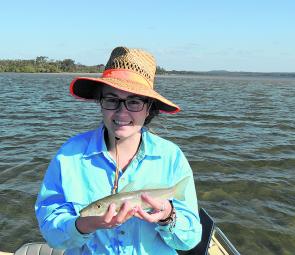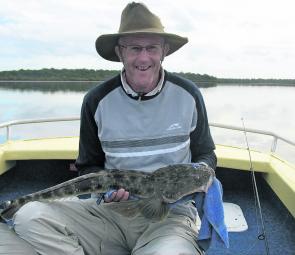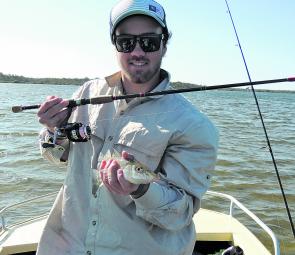Many people think the only place you will catch estuarine fish is in deep water. Not true! In this article I’ll show you just how productive shallow water can be.
My boat is an old Trekker V-nose punt which is ideal, but you can still use a larger boat – you just need to exercise a little more care.
The first thing to do is locate an area with good yabby banks. These are a natural attractant for flathead, bream, whiting and (if you’re lucky) a golden trevally. Areas of scattered mangroves or shell banks will all hold fish at times and should always be given a workout.
Before you rush in and start casting, study the water. See which way it is flowing, and look for sand banks where water runs over the top and into deeper water. When I say “deeper water” that doesn’t necessarily mean 1m deep; any depth change should be assessed as a potential ambush point, in particular for flathead.
Don’t be scared to cast over any exposed bank into water on the other side. If you’re lucky enough to hook up and you need to follow, it’s only a matter of stepping out of your boat to play the fish!
One productive approach is to manoeuvre your boat downstream from your selected casting zone, holding the boat in position by dropping the motor into the sand. Then cast back up against the current, similar to a what a trout angler would do in a stream. This is particularly good if you can bring your lure or bait over a drop-off.
If there are any islands or large banks that create eddies, try laying back from the end and cast upstream, bringing your lure or bait into the eddy. Fishing in this manner also lessens the likelihood of spooking any fish lying in wait.
Up here at Tin Can we have plenty of room on most of the flats – ideal for long drifts. Where possible we try to manoeuvre the punt in such a way that we can drift for hundreds of metres. Covering such a large area lets us target a range of options, and if we find fish it’s only a matter of dropping the motor into the sand. When we want to move again we simply lift the motor, and let the current do the work. Electric tilt makes this easy and quiet.
Remember to always put a few casts in the direction that you’re drifting before you spook any potential hook-up. When you’re fishing with a mate, alternate your casting in different directions, systematically working all sides of the drift.
Both the run-in and run-out tides work well, the only difference being the flooding tide gives your target species room to spread out. This makes it harder to locate them and reduces your time in the strike zone, but there is less chance of you staying up there for the next tide!
The dropping tide, on the other hand, channels your targets into drains and deeper sections of the flats that may retain water even at the bottom of the tide. In these places flathead, bream and whiting lie in wait for the small baitfish and prawns coming off the banks. In some circumstances these fish stay there for next tide. If left undisturbed, the flathead can be the last ones to move off the banks, so remember: if the sand is covered, don’t dismiss the chance of a fish!
This sort of country is perfect for surface stickbaits and poppers, and there is no greater thrill than to see your lure hit on the surface. Shallow divers are always a good option, with their erratic retrieve kicking up small clouds of sand. Flathead can’t resist them! My most successful ones are the Berkley 60mm Frenzy Minnow shallow diver, Ecooda Minnow and the diminutive C’ultiva 55F.
Soft plastics and small blades catch their fair share as well, so pack some of those, too. With a range of lures, plus a few yabbies in the bucket, you will have all you need for a pleasurable drift of the flats.
This method of fishing involves endless casts so your gear has to be light for your comfort, and also for the species targeted. It’s good to carry 2 or 3 rods rigged differently so you don’t waste time changing lures.
My base outfit is a 2.4m Shimano Sonic Pro fitted with a Abu Orra SX20 spooled with 6lb Nanofil and 6lb Vanish fluorocarbon leader. My other outfits are similar, but are spooled with 10lb Nanofil and 15lb leader.
On your next trip, try the skinny water option. Remember: if the tinny doesn’t touch the bottom, you’re fishing too deep!
Reads: 2196
Kate Ballard with a typical skinny water whiting.

Frank Best pulled this 80cm flathead out of 150mm of water on a small blade.

Kieran Lancini with a 33cm whiting from the shallows.




